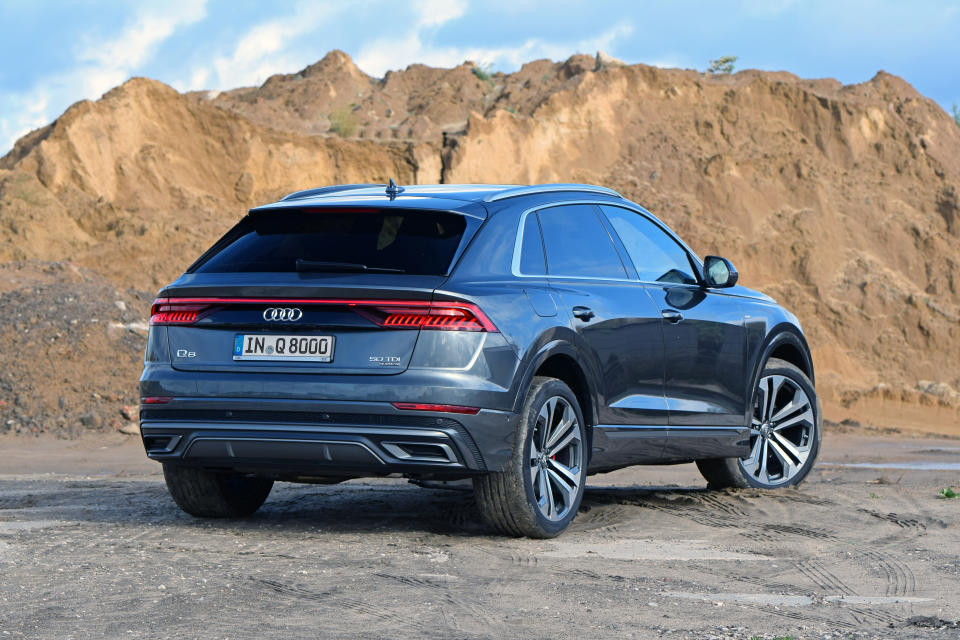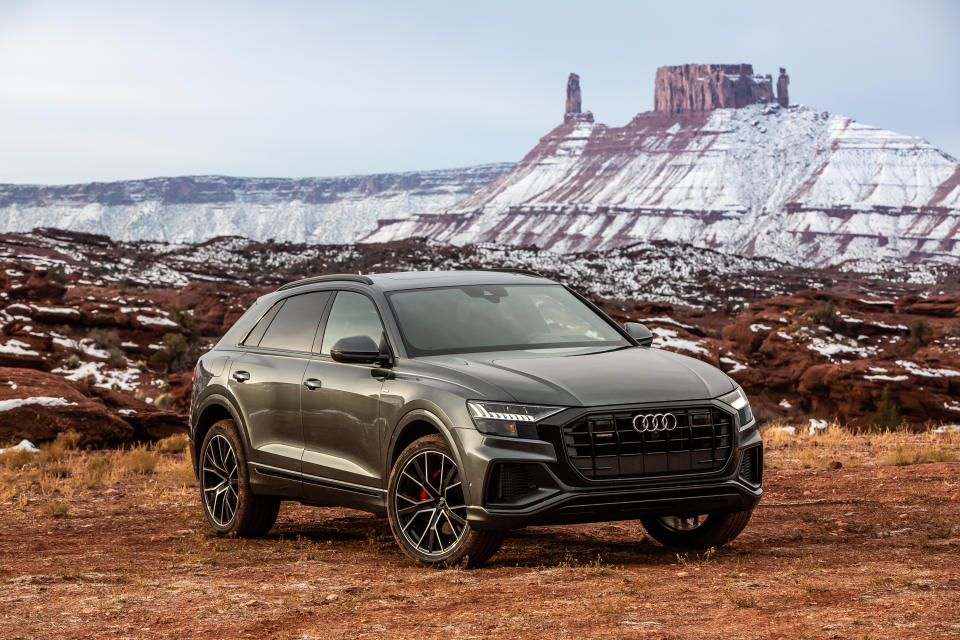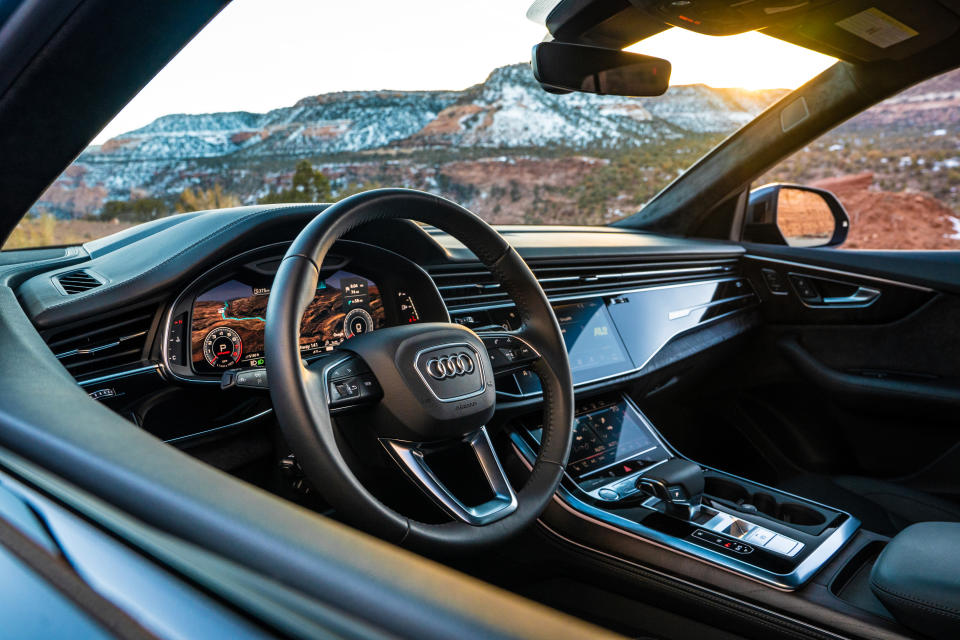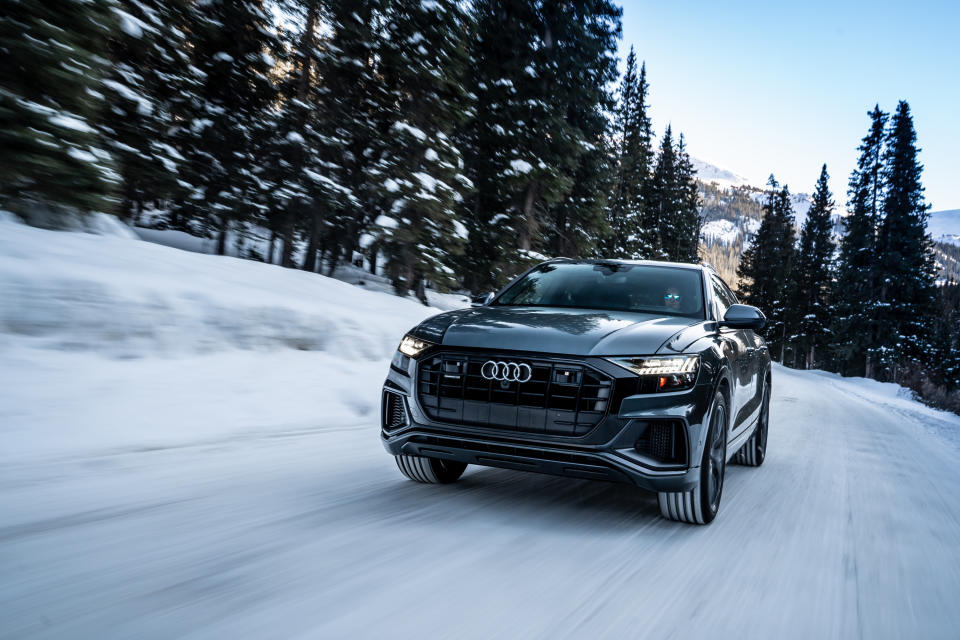'2 Dudes': Audi goes back to the future with the new Q8
You may be asking yourself: Do we really need another luxury SUV? Sorry, but the answer, at least from the auto manufacturers, is usually yes.
At least Audi (VOW.DE), with its new Q8, is trying to give us a blast from the past. Checking out the rear end of the car you’ll notice the full-length tail light wrapping around a taut hatch. To those unfamiliar, it’s an homage to Audi’s history with the legendary Quattro — a rally car that established the company’s bona fides as an all-wheel drive marque. See if you can spot the subtle similarities below:


Audi sought to capture the magic of that old legend with where the brand wants to go today. With a sporty stance and interior featuring Audi’s new dual screen setup, the Q8 aims to be the range topper of Audi’s SUV stable, but notice it’s not trying to be the biggest. See, the Q8 isn’t a seven passenger, luxury people mover. The Q8 is aiming for a sporty class of buyer, which means it must be a performance and luxury auto first, utility vehicle second. And that seems appropriate, given the Q8 starts at $68,000 ($88,690 as tested in our review).
A turbo-charged engine
To further separate the Q8 from its Q7 sibling, Audi went a different route with the engine. Rather than including the Q7’s tried-and-true supercharged V6, Audi went with its twin-turbo (i.e., not supercharged V6, pumps out 335 horsepower with 369 lb-ft of torque).

Those numbers are impressive, and while the Q8 did feel nimble around town, it isn’t exactly the pint-sized Audi Quattro from back in the day — this thing weighs a shade over 5,000 lbs. Tank-like construction and all-wheel drive systems aren’t exactly lightweight.
Interior, tech & GLOSA?
Audi’s interiors for many years were the best in the luxury sports car business. But Mercedes (DAI.DE) arguably may have topped them with ultra-luxe materials, and BMW (BMW.DE) has really been upping its game with new virtual cockpits and the latest iterations of its iDrive infotainment system.
Audi’s virtual cockpit has been around for a few years now and is pretty much bulletproof: looks great, easy to use, and gets the job done with minimal fuss. But Audi interior designers and engineers knew they had to push to stay near the top. Enter Audi’s new dual screen center stack setup — MMI touch response.

With MMI touch response, the upper screen handles most infotainment functions and vehicle options in a slick manner, with great graphic renderings and haptic touchscreen feedback to boot. The lower screen handles other functions like climate control and heated/ventilated seats options. It all works from a functional standpoint, which is most important; but, this level of cutting-edge tech is needed for a customer that expects the best in what is Audi’s top SUV.
And speaking of high tech, within the visual cockpit that faces the driver, Audi has also included the GLOSA, or Green Light Optimized Speed Advisory, system.

According to Audi, here’s how the GLOSA system works:
“When select Audi models approach a connected traffic light, it receives real-time signal information from the traffic management system that monitors traffic lights via the on-board 4G LTE data connection. When the light is red, the TLI feature will display the time remaining until the signal changes to green in the instrument cluster in front of the driver or in the head-up display (if equipped). This ‘time-to-green’ information helps reduce stress by letting the driver know approximately how much time remains before the light changes.”
We gave the GLOSA system a whirl in White Plains, New York, where the city has partially implemented GLOSA. It worked pretty much as we expected, giving us time and speed indications so that we could hit the lights coming up. Yes, it worked, but it wasn’t exactly super helpful; experienced drivers pretty much do this in their heads anyway.

But what it is here is a proof of concept system, if you will, for when cars will be interacting with their surroundings — and traffic systems most importantly — to help us usher in an autonomous, or semi-autonomous, future. It may not seem like much at the moment, but these are likely important baby steps.
More on performance
On the road, the Q8 was rock solid. Obviously the all-wheel drive performed admirably on the pavement, aiding in initial acceleration and keeping grip around the corners. But that engine — we found it wanting for more. This is supposed to be Audi’s top SUV, and with a sporty look conjuring up images of the old Quattro, we wanted to be wowed. We felt the Q8 needed to be pushed in order to get the level of performance that the Q8’s sultry looks suggested.

With the Q8 looking as sporty as it does (squint your eyes really hard and maybe you see its brother, the Lamborghini Urus?), I’m a little interested to see what a high performance SQ8 might bring to the table. We’ll have to wait for that, but for more on our thoughts on how the Q8 performed, check out the video above.
———
Pras Subramanian is a reporter for Yahoo Finance. You can follow him on Twitterand on Instagram.
Related stories:
2018 Range Rover Velar: Brawn and beauty—at a price
Road Test: 2018 Porsche Panamera Turbo S E-Hybrid Sport Turismo
Mercedes-AMG G 65 Final Edition: Love it or hate it, the G-Wagon makes a statement


